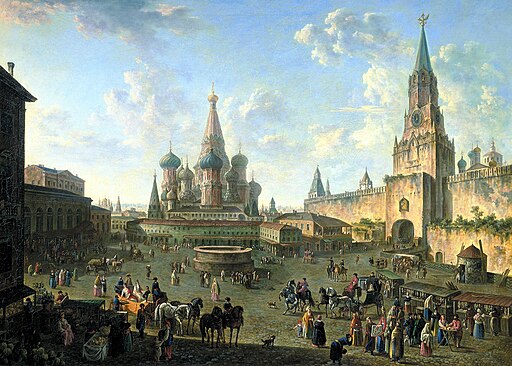
This marble statue of a Kouros is one of the earliest sculptures of a human figure carved in Athens from 590–580 B.C.
The statue was used to mark the grave of a young Athenian aristocrat. Kouros means youth, or boy, especially of noble rank, in ancient Greek.
The rigid stance with the left leg forward and arms straight down the side was derived and influenced by monumental Egyptian statues.
The Egyptian figures usually wore loincloths or other clothing and typically represented only the Kings of Egypt.
The Greek innovation was that sculpture is cut away from the stone and was not embedded in rock. There is also no stone holding the legs together.
There is more free space between the arms and the chest. In essence, this figure was freed from the rock.
This pose provided a simple style used by Greek sculptors in the 6th century B.C. as they learned the art of sculpting human figures.
This early sculpture featured geometric forms and anatomical details that were rendered in beautiful proportional patterns.
Greek marble nude sculpture evolved with experimentation. In the classical period, a century after this figure, Greeks made figures that stood in contrapposto.
Contrapposto was a more natural pose with a turned waist where the weight is shifted to one leg. The body became asymmetrical and more natural.
The nude first became significant in art through Ancient Greece. Athletic competitions influenced Greek culture at religious festivals, which celebrated the human body.
The athletes competed in the nude, and the Greeks considered that the athletes represented the ideal in humanity and culture.
The Ancient Greeks associated the male nude form with triumph, glory, and moral excellence. Images of naked athletes stood as offerings to the Gods in holy sanctuaries, and athletic nudes portrayed Greek religious gods.
Western art, through Roman copies of Greek nude sculpture, borrowed the artistic language of the nude.
Nudity portrayed the perfected ideal conceptually and moved the mind and the passions.
The famous Laocoön Statues influenced Michelangelo’s Sistine Chapel nudes.
The Laocoön statues originated and evolved from the Statue of a Kouros.

This Statue of a Kouros was the beginning and birth of the Western art tradition of many sculptural masterpieces that we see in Art Museums today.
Statue of a Kouros
- Title: Statue of a Kouros
- Date: ca. 590–580 B.C.
- Period: Archaic
- Culture: Greek, Attic
- Medium: Marble, Naxian
- Dimensions: H: 76 in. (195 cm); W: 20 in. (52 cm)
- Museum: Metropolitan Museum of Art – MET, New York, USA
Statue of a Kouros
New York Kouros
MET Greek and Roman Art Collection
- Statue of a Kouros
- Amathus Sarcophagus
- Mycenaean Terracotta Female Figures
Contrapposto
MET Egyptian Art Collection
- The Temple of Dendur
- The Sphinx of Hatshepsut
- William the Faience Hippopotamus
MET Asian Art Collection
- Luohan – Yixian Glazed Ceramic Sculpture
- Pillow with Landscape Scenes – Zhang Family Workshop
- Jar with Dragon
- Fine Wind, Clear Morning by Katsushika Hokusai
Anavysos Kouros
MET Ancient Near Eastern Art Collection
- Sumerian Standing Male Worshiper
- Head of a Beardless Royal Attendant – Eunuch
- Human-Headed Winged Bull (Lamassu)
MET Islamic Art Collection
- Blue Qur’an
- Marble Jar of Zayn al-Din Yahya Al-Ustadar
- The Damascus Room
MET Arts of Africa, Oceania, and the Americas Collection
- Benin Ivory Mask
- African Face Mask – Kpeliye’e
- Sican Funerary Mask – Peru
- Ceremonial Axe – Papua New Guinea
Anavysos Kouros & Kore
MET European Sculpture and Decorative Arts Collection
- “Hercules the Archer” by Antoine Bourdelle
- “Orpheus and Eurydice” by Auguste Rodin
- “Perseus with the Head of Medusa” by Antonio Canova
- “The Little Fourteen-Year-Old Dancer” by Edgar Degas
MET Medieval Art Collection
- “The Last Supper” by Ugolino di Nerio
- Plaque with the Journey to Emmaus and Noli Me Tangere
- Doorway from the Church of San Nicolò, San Gemini
THE GETTY KOUROS
MET Arms and Armor Collection
- Blade and Mounting for a Sword (Katana)
- Double-Barreled Flintlock Shotgun
MET Photograph Collection
- Loie Fuller Dancing
- Sala Delle Statue, Vatican
- Gardner’s Photographic Sketchbook of the War
Metropolitan Kouros
~~~
“Everything flows and nothing abides, everything gives way, and nothing stays fixed.”
– Heraclitus
~~~
Photo Credit: 1) By Wikipedia Loves Art participant “Futons_of_Rock” [CC BY 2.5], via Wikimedia Commons; InSapphoWeTrust from Los Angeles, California, USA, CC BY-SA 2.0 creativecommons.org/licenses/by-sa/2.0>, via Wikimedia Commons
Popular this Week








 Sponsor your Favorite Page
Sponsor your Favorite Page SEARCH Search for: Search Follow UsJoin – The JOM Membership Program
Sponsor a Masterpiece with YOUR NAME CHOICE for $5
Share this:
- Tweet
